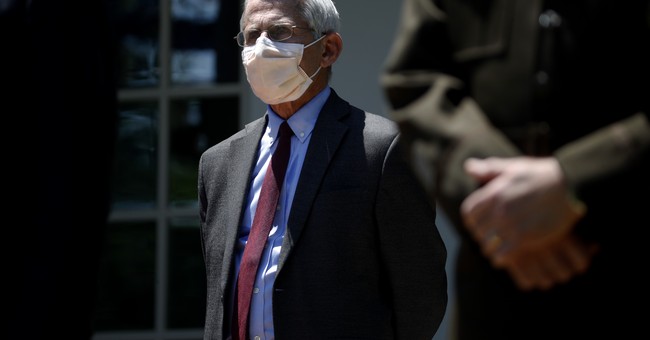The US is Dramatically Overcounting Coronavirus Deaths
The opinions expressed by columnists are their own and do not necessarily represent the views of Townhall.com.
Editor's Note: Timothy Craig Allen, MD, JD, contributed to this column.
Over 86,500 people have reportedly died in the United States from the Coronavirus, and the fear generated by those deaths is driving the public policy debate. But that number is a dramatic overcount. Our metrics include deaths that have nothing to do with the virus. The problem is even worse as the Centers for Disease Control over counts even some of these cases and the government has created financial incentives for this misreporting. Relying on these flawed numbers is destroying businesses and jobs and costing lives.
“The case definition is very simplistic,” Dr. Ngozi Ezike, director of Illinois Department of Public Health, explains. “It means, at the time of death, it was a COVID positive diagnosis. That means, that if you were in hospice and had already been given a few weeks to live, and then you also were found to have COVID, that would be counted as a COVID death. It means, technically even if you died of clear alternative cause, but you had COVID at the same time, it’s still listed as a COVID death.”
Medical examiners in Michigan use the same definition. In Macomb and Oakland Counties, where most of the deaths occurred, medical examiners classify any deaths as Coronavirus deaths when the postmortem test is positive. Even people who died in suicides and automobile accidents meet that definition.
Still, these broad definitions are not due to a few rogue public health officials. The rules direct them to do this. Unlike other countries, “if someone dies with COVID-19, we are counting that as a COVID-19 death,” as Dr. Deborah Birx, the White House coronavirus response coordinator, recently noted.
Classifications go beyond even these broad categories. New York is classifying cases as Coronavirus deaths even when postmortem tests have been negative. Despite negative tests, classifications are based on symptoms, even though the symptoms are often very similar to those of the seasonal flu. The Centers for Disease Control guidance explicitly acknowledges the uncertainty that doctors can face. When Coronavirus cases are “suspected,” they advise doctors that “it is acceptable to report COVID-19 on a death certificate.”
That isn’t just a theoretical issue. On April 21st, when New York City’s death toll rose above 10,000, the New York Times reported that the city included “3,700 additional people who were presumed to have died of the coronavirus but had never tested positive” – a more than 50 percent increase in the number of cases.
But the problem is worse than this broad definition implies. Birx and others believe that the CDC is over counting cases. The Washington Post reports they are concerned that the CDC’s “antiquated” accounting system is double counting cases and inflating mortality and case counts “by as much as 25 percent.”
There are additional reasons for concern. Some doctors feel pressure from hospitals to list deaths as due to the Coronavirus, even when they don’t believe that is the case, “to make it look a little bit worse than it is.” There are financial incentives that might make a difference for hospitals and doctors. The CARES Act adds a 20 percent premium for COVID-19 Medicare patients.
Incentives matter. When the government increased the disability compensation for air traffic controllers, a lot more controllers suddenly started claiming to be disabled. When unemployment insurance payments increase, more people become unemployed and stay unemployed for longer periods. When the government offers flood insurance that charges everyone the same insurance premium regardless of the risk level in their area, more people build homes in frequently flooded areas.
The Washington Post and others claim that we are undercounting the true number of deaths. They reach that conclusion by showing the total number of deaths from all causes is greater than we would normally expect from March through early May, and that this excess is actually due to deaths not being accurately labeled as due to the Coronavirus. But these are simply not normal times. Lots of people with heart and other problems aren’t going to the hospital for fear of the virus. Surgeries for many serious conditions are being put off. The stress of the situation is increasing suicides and other illnesses.
Deaths that have absolutely nothing to do with the Coronavirus count as virus deaths. Add to that claims that the CDC is double counting some of these improperly identified cases and the perverse financial incentives created by the government, and you have a real mess when crucial decisions are being made based in large part on this data.
Erroneous data unduly scare people about the risks of the disease. It keeps the country locked down longer than necessary, which destroys peoples’ lives and livelihoods in many other ways. Exaggerated fears of the virus endanger lives by keeping people from obtaining treatment for other medical problems. It also makes it impossible to accurately compare policies across countries.
It is hard to believe that we are basing such crucial decisions on such flawed data.
Lott is the president of the Crime Prevention Research Center. Allen is a Governor of the College of American Pathologists and Professor and Chair of the Department of Pathology at the University of Mississippi Medical Center. He is also on the Board of Directors and the Academic advisory board for the Crime Prevention Research Center.




No comments:
Post a Comment